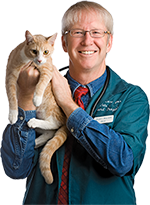How many things would you rather do than brush your dog’s teeth?
If you’re like most pet owners I talk to, that’s a long list. But not only shouldn’t it be that way, it really doesn’t have to!
First, let’s get one misconception out of the way: You don’t need your veterinarian. Just as you need a professional dental cleaning to remove problems the toothbrush can’t reach, so do your dogs. That means, just as you have to see the dentist, your pets need to see the veterinarian. That’s because the real problems are below the gum line, and your dog will need to be anesthetized so that area can be completely and painlessly cleaned. Skip that step, and serious problems including pain and tenderness with chewing, foul-smelling breath, and infection can take hold.
Beyond veterinary dental care, the other essential component in caring for a dog’s teeth is to rid the teeth of built up tartar and plaque. There are numerous ways to keep teeth clean, but as always, follow your veterinarian’s guidance first and foremost.
The gold standard of at-home dental care is brushing a pet’s teeth. If that makes you shudder, please believe me when I tell you it’s possible to make tooth brushing fun for your dog, which should make it fun for you, too. Start by finding a pet specific tooth brush or pet wipes that can be used to clean teeth, such as my favorites, Earthbath Tooth and Gum Wipes.
If using a toothbrush, place peanut butter or a soft treat on the toothbrush and let your pet lick this off the toothbrush to begin with. Next, get your pet comfortable with her mouth being touched by gently touching it and feeding a treat. Each time the mouth is touched or lip gently lifted up, feed a tasty treat.
Once she’s comfortable both with the sight of a toothbrush and her mouth being handled, combine the two by lifting her lip and bringing in the toothbrush with the soft treat smeared on it. Wipe the treat against the outside of the teeth, and then let go of the mouth for the dog to lick the treat off her teeth.
Practice moving to different areas of the mouth and opening it from above to get the inside teeth as well. Continue with rewards given on the toothbrush, or giving loose treats, depending on the dog and situation.
Once the dog becomes comfortable, a pet-specific toothpaste can be used and treats given as you brush or immediately after brushing. My father, Dr. Marty Becker, is a veterinarian who not only advises at-home preventive dental care, but he and my mother daily brush their dogs’ teeth. The dogs are excited at getting their teeth brushed up and will line up for their turn, because teeth brushing earns them special praise and a dental chew, or what my dad calls an edible toothbrush.
Another way to clean the teeth is with pet wipes that can be swiped on the tooth using a finger. These are a great option for dogs that are more sensitive to an object being moved towards them, but they are more comfortable with petting and touch by their person. They can be wrapped around a finger and then the finger can be used to glide and feel along the teeth to clean.
To get a dog accustomed to the wipes, do the training in a similar manner to the toothbrush with a spreadable treat on the surface of the wipe that the dog can lick off when it’s left on her teeth. This associates opening the mouth and having teeth and gums touched with getting a reward. If the dog is mouthy with fingers, do this in small steps of lifting her lip or gently touching the outer part of her muzzle.
If she stays calm, reward with a soft treat. Then gradually work up to using the teeth wipes and cleaning different parts of her mouth, treating as often as needed to keep her calm.
Other methods for cleaning teeth are using a dental formulated diet made with special ingredients and composed in a shape that works to keep the tooth surface cleaner. Dental chews can also scrape buildup off teeth to a certain extent, and some have enzymes that work to break down plaque and tartar on the teeth. Talk to your veterinarian about his or her recommendations on how to best protect your pet’s dental health.


